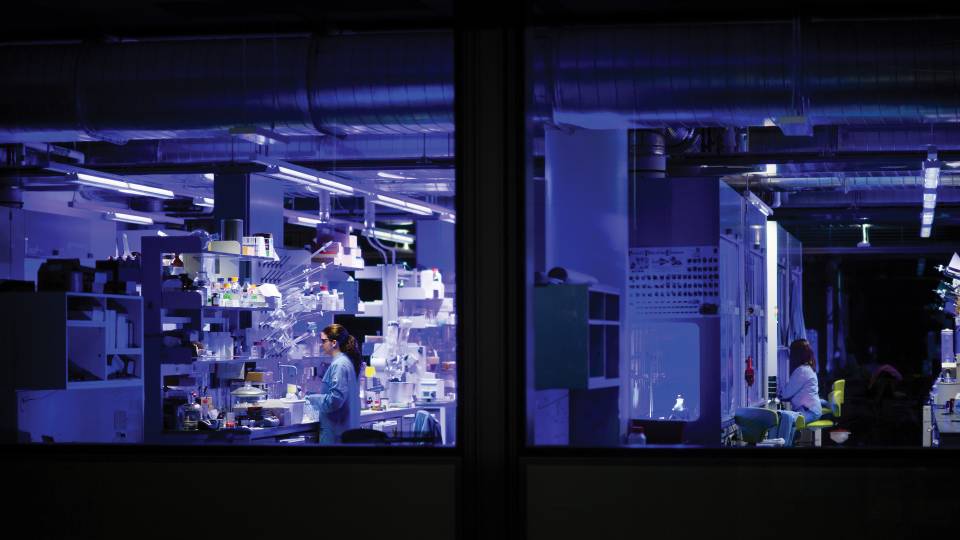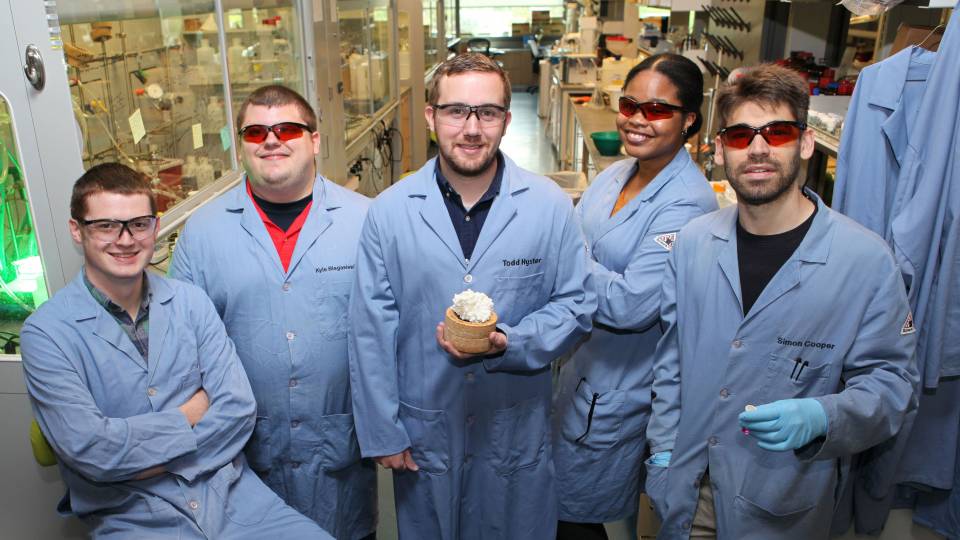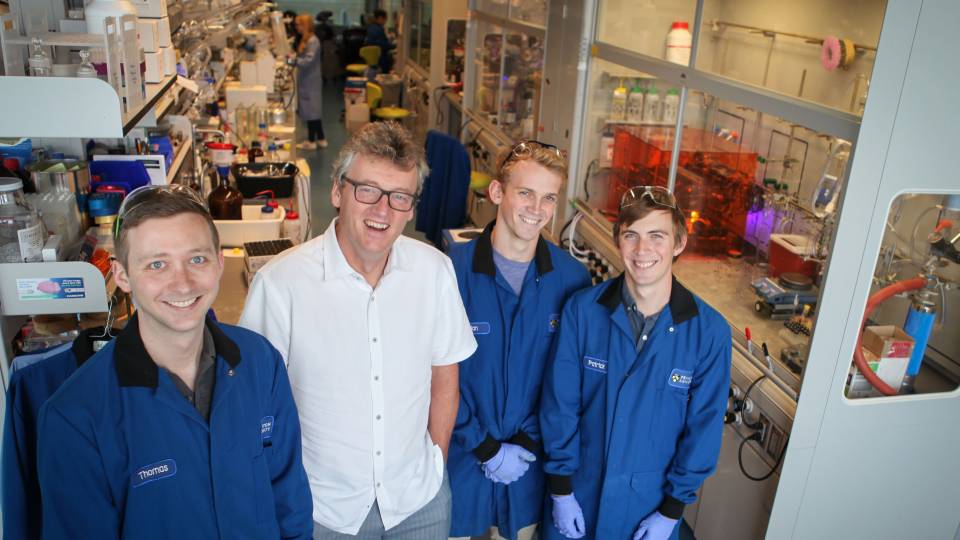Scientists can now take that "a-ha" moment to go with a method Princeton University researchers developed — and successfully tested — to speed up the chances of an unexpected yet groundbreaking chemical discovery.
The researchers report this month in the journal Science a technique to accomplish "accelerated serendipity" by using robotics to perform more than 1,000 chemical reactions a day with molecules never before combined. In a single day of trials, the Princeton researchers discovered a shortcut for producing pharmaceutical-like compounds that shaves weeks off the traditional process, the researchers report.
The basis of the research was to combine new technology with a unique, rapid-reaction approach that could allow chemists to explore unheard-of and potentially important chemical combinations without devoting years to the pursuit, explained senior researcher and co-author David MacMillan, the James S. McDonnell Distinguished University Professor of Chemistry at Princeton and chair of the department. MacMillan worked with lead author Andrew McNally, a research associate in MacMillan's lab, and Princeton graduate student and co-author Christopher Prier.
"This is a very different way of approaching how we come up with valuable chemical reactions," MacMillan said.
"Our process is designed specifically for serendipity to occur. The molecules that should be combined are those for which the result is unknown," he said. "In our lab, we used this technique to make new findings in a much more routine and rapid fashion, and we show that if you have enough events involved, serendipity won't be rare. In fact, you can enable it to happen on almost a daily basis."
The MacMillan lab's technique does more than just expedite the discovery process — the researchers actually developed a unique framework for creating new materials or finding better ways of producing existing ones, said Stephen Buchwald, a professor of chemistry at the Massachusetts Institute of Technology.
"This is a particularly brilliant approach," said Buchwald, who is familiar with the work but had no role in it.
"Usually, one takes molecules that one thinks will react and tries to figure out the best way to achieve that reaction," he said. "This team took molecules for which there was no obvious reaction between them and looked for 'accidental' reactivity. This approach could be useful for any field that requires new types of matter or a more efficient means of synthesizing known compounds."
Illustrating that principle, the Princeton researchers combined two molecules with no history of reacting to generate the type of chemical functionality found in eight of the world's top 100 pharmaceuticals, MacMillan said. The reaction involved a nitrogen-based molecule known as an amine that has a hydrogen and carbon pair, and a circle of atoms stabilized by their bonds known as an aromatic ring.
The result was a carbon-nitrogen molecule with an aromatic ring, a building block of many amine-based pharmaceuticals, explained MacMillan. This class of drugs mimics natural amine molecules in the body and includes medications such as antihistamines, decongestants and antidepressants. In drug development, chemists "tweak" organic molecules to enhance their ability to bind with and disrupt enzymes in a biological system, which is how pharmaceuticals basically operate, MacMillan said. A molecule with an aromatic ring has increased reactivity and makes the tweaking process much easier, he said, but attaching the aromatic ring is a process in itself that typically involves two to three weeks of successive chemical reactions.
The reaction MacMillan and his team found provides a quick way around that.
"We quickly realized that any pharmaceutical research chemist could immediately take these very simple components and, via a reaction no one had known about, start assembling molecules with an adjacent aromatic ring rapidly," MacMillan said.
"Instead of having to construct these important molecules circuitously using lots of different chemistry over a period of days if not weeks, we can now do it immediately in the space of one chemical reaction in one day."
Buchwald said that the rapid production of this molecule is as surprising as it is significant.
"The way these types of molecules — alpha aryl amines — were produced in this project is highly efficient, and no person could truthfully say that they would have predicted this reaction," Buchwald said. "This group was able to take a reaction that no one knew was possible and make it practical and useful in a very short time. This really speaks to the power of their overall method."
MacMillan conceived of accelerated serendipity after reflecting on his doctoral work at the University of California-Irvine during the 1990s. His work there hinged on two unforeseen yet important reactions that occurred in the span of six years, he said. When envisioning the project reported in Science, MacMillan calculated that if, in a single day, he ran the equivalent of one reaction per day for three years — nearly 1,100 reactions — the odds favored a new discovery, he said.
The Princeton team began running reactions once a day using a high-throughput, automated reaction accelerator in Princeton's Merck Center for Catalysis, combining on a one-to-one ratio molecules with no reported effect on each other.
Central to the process is a technique developed in MacMillan's lab and reported in Science in 2008 to synthesize chemical reactions using a low-power light source, such as a household light bulb. Known as photoredox catalysis, the reaction takes place when inorganic catalysts absorb light particles from the light source then pass an electron onto the organic molecules, which creates, or synthesizes, a new compound.
For the latest work, MacMillan and his team carried out this process on the molecules before each reaction cycle. Because the use of photoredox catalysts in organic-compound synthesis is relatively new — it has been typically used by chemists and in industry for processes such as energy storage and hydrogen production — it has not been as thoroughly explored as the more common method of using catalysts derived from metals such as nickel, gold and copper, MacMillan said. Thus, he said, elements with no history of reacting with each other could possibly produce results under this different approach.
"If one wanted to find new reactions, it would have to be done in a completely new area of chemistry research where the chances of finding something completely unknown are probably higher than continuing in an area that has been studied for the past 50 years," MacMillan said.
The Princeton researchers produced numerous new reactions, but "new" does not necessarily equal interesting or important, MacMillan said. They analyzed and experimented with each new reaction for its potential application, a process that revealed the nitrogen-carbon molecule with the aromatic ring.
An important feature of the Princeton researchers' molecule — like any important discovery — is that its application extends beyond the material itself, MacMillan said. He and his colleagues have begun mining the very process that created the molecule for indications that other novel reactions can be brought about.
"If we found this was one really valuable reaction, we wondered what others exist that we just don't know about," MacMillan said.
"Another very valuable aspect of the molecule we created is that once we understood how it happened, it set us up to design other completely new reactions based upon our understanding of what happened initially," he said. "Now, we're applying similar techniques broadly, finding new reactions continually and determining which ones are important.
"To us that really proved the point of why you want serendipitous findings," MacMillan said. "They present new knowledge, and based upon that new knowledge you can invent."
The research was published Nov. 25 in Science and was supported by a grant from the National Institutes of Health, and gifts from Merck, Amgen, Abbott and Bristol-Myers Squibb.



